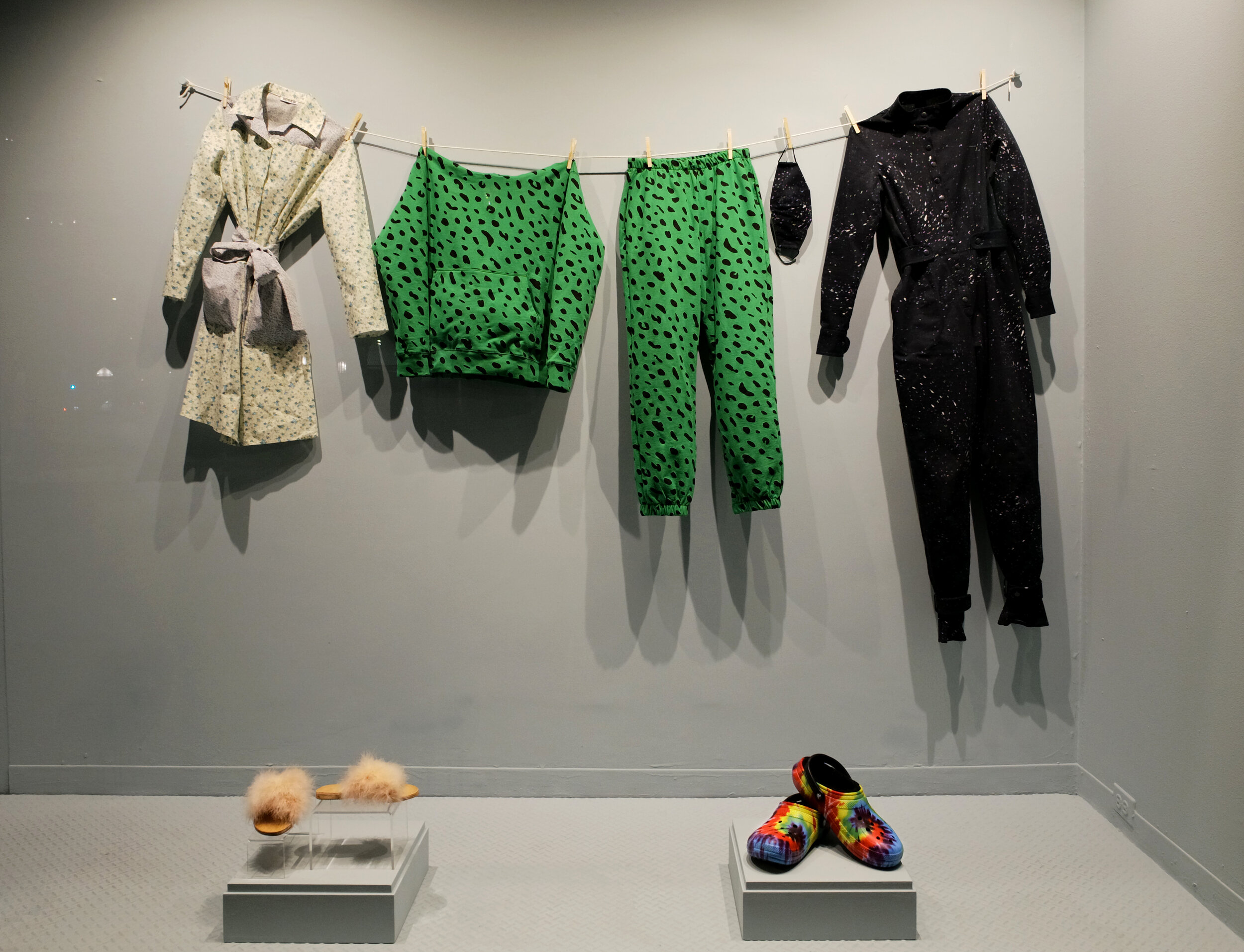Homewear/Homemade
In early 2020, 3.9 billion people worldwide were ordered to stay home, while millions more experienced staggering unemployment. Tensions produced by this quarantine led to new explorations of creativity and modes of dress at home. Women, especially mothers, faced a return to domesticity that was magnified by the rise of garments like the housedress, which questions traditional gender roles and harkens to a time when functionality for housework was paramount. The need for comfort and simplicity amidst uncertainty led to the popularity of sweat suits, jumpsuits, and Crocs, echoing in solidarity the uniforms of heroic healthcare workers. Many sought relief from the anxiety, tedium, and financial strain of lockdown through ‘do-it-yourself’ and ‘make do’ crafts. Virtual communities shared open-source knitting and sewing projects, while techniques like tie-dying flourished. These trends were adopted by top designers and mass-retailers alike, who responded with ingenuity, offering sewing and dye kits, and in the case of JW Anderson, releasing his pattern for a trending cardigan style via social media.
Batsheva (American, founded 2016)
Batsheva Hay (American, born 1981)
Blue Floral Housedress, 2020
Cotton plain weave printed with multicolor floral motifs
Courtesy Batsheva
With stay-at-home orders in place during 2020, sweatsuits were quickly embraced as the daily uniform by most people; however, many women found an alternative option in the housedress, such as this one designed by Batsheva Hay. Inspired by her grandmother-in-law, and the tznius (Judaism’s principles of modesty), Hay created housedresses that employ traditionally feminine floral prints and colors. With a wide A-line fit and large patch pockets to hold household tools, the housedress is made to be both comfortable and practical. The recent rise in popularity of the housedress is about more than comfort and practicality: it also evokes a sense of nostalgia. Its resurgence coincided with stay-at-home orders that found people embracing domestic life and pursuing coping mechanisms that were traditionally considered women’s work, such as baking, sewing, and knitting. Long associated with the role of the housewife in the mold of Claire McCardell’s 1942 “Pop-over Dress”—famously sold with its own oven mitt—this modern housedress probes the domestic tensions brought on by the pandemic, as women and mothers confronted added housekeeping and childcare demands at home.
Clare V. (American, founded 2008)
Clare Vivier (American, born 1971)
Green Jaguar sweatsuit, autumn 2020
Green cotton knit printed with black jaguar motif
Courtesy Clare V.
Like many other small fashion brands, Clare Vivier, founder of Clare V, was forced to close her eight retail stores and furlough many of her employees in early March 2020. Though known primarily for her accessories, Vivier quickly realized it was, in fact, her comfortable, laid-back apparel that was selling during the early days of quarantine. As a result, Vivier fast-tracked the expansion of her apparel line. With life now centered in the home, buyers were increasingly interested in fashionable loungewear, making matching sweatsuits in fun prints and bright colors the unofficial homebound uniform of quarantine.
Risen Division (American, founded 2017)
Andrea Lauer (American, born 1975)
“The Quimby” jumpsuit and matching mask, 2020
Black cotton sateen printed with silver “space dust” motif
Courtesy Andrea Lauer for Risen Division
As citizens were forced indoors by the pandemic, clothing lost the frills of outdoor life. Professional business attire and going-out clothes were replaced by leisurewear and utilitarian garments. Andrea Lauer, designer and founder of Risen Division, dates the jumpsuit’s inception to 1919 and describes it as a garment connected to notions of progress, technology, and labor that developed after the first World War. At this time in history, the world was grappling with the devastating effects of another global pandemic: the 1918 Flu. Today, the popularity of the jumpsuit has reemerged under similar circumstances. Swift technological progress has provided a way for businesses to survive, schools to remain in session, and loved ones to connect as we collectively manage quarantine and social distancing. The jumpsuit exemplifies comradery through genderless, utilitarian dressing while paying homage to the essential workers who have carried the world through the Covid-19 pandemic.
Brother Vellies (American, founded 2013)
Aurora James (Canadian, born 1984)
Marabou Lamu Sandals in Rose, 2016
Lamu feather mounted on leather upper with vegetable-tanned leather sole
Courtesy Brother Vellies
While utilitarian footwear and bare feet were embraced by most during the Covid-19 stay at home orders, some women opted for a more fashionable alternative. Feathered slip-on shoes, like this pair from luxury brand Brother Vellies, were promoted in 2020 by various media outlets, such as New York Magazine and Coveteur. These slippers offered a playful option for at-home footwear. The hyper-femininity of the feathered shoe evokes a nostalgia for the boudoir glamour of the 1950s ‘domestic goddess.’ Though the Lamu sandal was originally designed to be worn in public, this modern interpretation of the slipper offers comfort and versatility. It has become a go-to choice for both domestic and public wear, and further blurs the disintegrating lines between fashion in the private and public spheres.
Crocs (American, founded 2002)
Classic Clog, 2020
Croslite™ (proprietary closed-cell resin)
Courtesy Crocs
As Covid-19 raged through 2020, sales of high heels and dress shoes plummeted. With most Americans stuck at home, and many dependent on virtual workplace solutions, dressing the feet in work-appropriate shoes became obsolete. Slipper sales surged, refocusing our attention on slip-on leisure brands like Crocs and UGG. Crocs teamed up with celebrities to offer limited edition collections with international celebrities Justin Bieber and Bad Bunny, further highlighting the spread of comfort-focused clothing sensibilities through all walks of life. Crocs, a popular shoe brand among medical and healthcare workers, launched “Free Pair for Healthcare” at the outset of the pandemic. Over the course of 45 days, Crocs donated more than 860,000 shoes globally to frontline healthcare workers in the fight against Covid-19.
Collina Strada (American, founded 2009)
Hillary Taymour (American, born 1988)
Ritual Dress, spring/summer 2020
Tie-dyed Rose Sylk (rose bush cellulose)
Courtesy Hillary Taymour
As life in quarantine became the new normal for many people, handicrafts rose in popularity for at-home activities. These projects, which often repurposed and reused existing garments and materials, correlated with a rising interest in sustainability. Tie-dye was a particularly timely trend in home-based crafts, as the aesthetic was already experiencing a resurgence in the fashion world prior to the Covid-19 pandemic. Hillary Taymour’s design for Collina Strada embodies both the ethos of sustainability and a revived interest in arts and crafts, offering a fashion industry interpretation of several 2020 trends, in a comfortable housedress silhouette that became a hallmark of lockdown style. The brand’s advocacy for, and commitment, to sustainability and social awareness further positions Collina Strada as another fashion voice in the important conversations around issues of racism and social justice. “We are in a crucial state of change right now and the more we do, the more we can impact others to take actions,” says the brand.
Reese Cooper (American, founded 2018)
Reese Cooper (American, born 1999)
Assembled Chore Coat, 2020
Khaki corduroy assembled chore coat, embroidered patches
Courtesy Karla Otto
Reese Cooper (American, founded 2018)
Reese Cooper (American, born 1999)
Chore Coat Kit, 2020
Camouflage cotton canvas coat kit, embroidered patches
Courtesy Reese Cooper
In response to being at home and the widespread economic hardship inflicted by the pandemic, consumers and brands looked for opportunities to be both creative and resourceful. Designers like Reese Cooper began selling do-it-yourself kits, such as this chore coat kit to be constructed and customized at home. These D.I.Y. kits encouraged consumers to get involved with the process of garment construction, as in-person shopping, shipping, and supply chains were all affected by Covid-19. Brands and designers also struggled to gain access to imported materials in the wake of Covid-19’s impact on international manufacturing and shipping. Out of concerns around supply chain interruptions, Cooper leveraged scrap fabric that was readily available at his studio to produce new clothing and to include in his innovative kits for home-sewers. This kit includes a flat textile printed with the phrase: “This is a RCI home sewn garment. Designed by REESE COOPER® and constructed by someone inspired by doing, not watching. Made with RCI Materials but assembled to reflect the person wearing it.” When the chore coat is assembled according to the instructions this text appears beneath the left breast pocket, but it can be featured elsewhere depending on how the maker chooses to cut the pattern.
Reese Cooper (American, founded 2018)
Reese Cooper (American, born 1999)
Tie-dye Kit, 2020
white cotton T-shirt, RIT dyes
Courtesy Reese Cooper
During months of quarantine, hobbies and crafts became a go-to activity for millions of Americans looking to entertain themselves indoors. Consumers took to social media to share their do-it-yourself garments and document the process of creating them. While tie-dye has traditionally been a popular technique, during lockdown many brands and fashion houses capitalized on the tie-dye fashion trend already visible on the 2019 and early 2020 runways, adapting it to the D.I.Y. movement by offering kits such as this one by Reese Cooper. The kit includes one white crew neck t-shirt and two colors of dyes for customization. Cooper created a collection of exclusive hues in partnership with RIT, which can be used to piece-dye the entire shirt or be applied in individualized patterns at the creator’s preference. Dyeing instructions that are permanently printed on the shirt advertise the resulting garment as a D.I.Y product.
Shara Sprecher (American, born 1978)
Handknit Cardigan, 2020
Blue, pink, purple, and yellow wool, mohair, and cashmere knit
Courtesy Shara Sprecher
Johanna Tomoka (Nigerian, born 2001)
Crochet Cardigan, 2020
Red, orange, burgundy, yellow, green, and light blue wool knit
Courtesy Johanna Tomoka, @josyarnjoint
Brooke Bailey (American, born 1996)
Handknit Cardigan, 2020
Black and grey wool knit
Courtesy Brooke Bailey
Caitlin Culligan (American, born 1996)
Handknit Cardigan, 2020
Red, orange, black, yellow, green, and light blue wool knit
Courtesy Caitlin Culligan
As a way to spend their days creatively, to connect to a favorite celebrity, or to hack a piece of high fashion from one of England’s top designers, people turned to recreating JW Anderson’s Colourblock Patchwork Cardigan during quarantine. The sweater gained social media recognition after it was worn by Harry Styles in February 2020, and became a sensation on TikTok after influencer Liv Huffman successfully recreated and shared her own version. These cardigans were all made in America, but recreations posted under the hashtag #HarryStylesCardigan hail from all around the world, including Chile, Mexico, and Germany. Although based on the same garment and pattern, all copies represent an array of skill levels and color preferences at the discretion of each crafter. The trend fostered a sense of community and comfort through creators’ shared love of fashion, yarn, and all things Harry Styles during this period of separation. The cultural significance of JW Anderson’s cardigan has been recognized by other institutions and was even added to the Victoria & Albert Museum’s permanent fashion collection.
Graphic: JW Anderson Colourblock Patchwork Cardigan/Knit Pattern, July 1st, 2020. Created by Ruth Herring for JW Anderson (British, founded in 2008). Public Domain.
Following the incredible number of copies of the Colourblock Patchwork Cardigan posted on social media, JW Anderson released a detailed instruction manual for his sweater as a free download. According to the designer, the pattern was a show of appreciation for all the pieces that had been created by members of the TikTok community. By publishing the pattern on the brand’s website, JW Anderson joins a historical trend of making garment patterns publicly available during times of distress. Previous examples include the TuTa jumpsuit pattern released by Italian designer Thayat (Ernesto Michahelles) during the 1918 Flu pandemic, and knitting patterns made available for British households during WWII that encouraged the civilian population to help troops by making socks, hats, and gloves.













